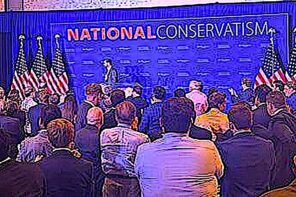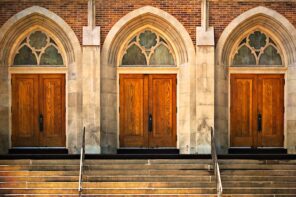On December 3, 2016, San Francisco Archbishop Salvatore Cordileone confirmed sixteen Catholics, both young and mature adults, at Mary Star of the Sea Church in San Francisco.
There would be nothing notable about an Archbishop performing a confirmation ceremony except for this: according to the Traditional Latin Mass Society of San Francisco, it was the first confirmation in San Francisco performed in Latin—the “Extraordinary Form” of the Catholic Mass—since the reforms of Vatican II in the 1960s.
The San Francisco diocesan newsletter ran only a small blurb about the event, stating that the people being confirmed had been undergoing instruction in Catholicism from Rev. Bill Young at Saint Monica church, which is one of two parishes in San Francisco that regularly offer a Latin Mass. The confirmation class made a special request of the Archbishop in 2014 that they would be confirmed in the Extraordinary rite.
Cordileone has long had an interest in reviving the Latin Mass. In 2014, just a year after Pope Francis was elected, Cordileone told Latin Mass Magazine that when he chose to celebrate Mass in Latin, he was promoting the vision of the recently resigned Pope Benedict: “to make this form of the Mass more easily available” and “to promote it” as a “useful tool of evangelization.” When asked if Latin Mass would continue to appeal to small groups of people “at odd hours in out of the way locations,” Cordileone said that younger Catholics who might be drawn to Latin Mass “did not go through liturgy wars” after Vatican II and “are not jaded by that.”
When Cordileone was installed as Archbishop of San Francisco in 2012, the principle co-consecrator was Cardinal Raymond Leo Burke, who has mentored Cordileone for many years and is also an enthusiast for the pre Vatican II form of worship. And just a few weeks before Cordileone performed the Latin Mass confirmation, Burke was among four cardinals who announced to the media that they had filed a “dubia”—a request for formal clarification—with Pope Francis regarding Amoris Laetitia, the pope’s recent exhortation on families.
Particularly, the four cardinals were concerned about actions perceived to be “intrinsically evil,” including communion for the divorced and remarried. When they failed to get a response from the pope, they alerted the media. The Catholic Herald noted it is highly unusual for cardinals to “go public like this.”
But “going public” is long what Cardinal Burke has tended to do. Known for his love of silk, brocade, lace, and other forms of Catholic clerical fashion, Burke, who was created cardinal by Pope Benedict in 2010, rose to prominence as one of the American church’s “culture warriors,” stating that the “feminized” church has a “man crisis,” suggesting families should not allow their children to have contact with “evil” gay family members, stating that Catholic politicians John Kerry and Nancy Pelosi should be denied communion, and serving on the advisory board to the Human Dignity Institute, which invited Steve Bannon to a conference at the Vatican in 2014.
More recently, Burke has remained in the public eye for his repeated criticisms of Pope Francis’ attempts at church reform. Francis has responded in kind by demoting Burke from the highest Vatican court in 2014 and demoting him again from the Congregation for Divine Worship in 2016. Burke is currently the prefect of the Knights of Malta, which is under investigation for dismissing an official. Burke was at the meeting where the official was asked to resign and claimed the pope was behind the request for resignation, which turns out to be a lie.
Meanwhile, in October of last year, Pope Francis elevated three Americans to cardinals, including Chicago’s Archbishop Blaise Cupich and Indiana’s Joseph Tobin. In both cases, the new cardinals represent Francis’ vision for the church, not Burke’s or Cordileone’s. Both have made immigrant rights a top priority; Tobin battled Mike Pence on the issue, and Cupich asked the USCCB to make immigration a key priority (America magazine’s Mike O’Loughlin notes that “[Cupich’s] request was denied”). Cupich is also a vocal supporter of the activist priest Fr. Michael Pfleger, who has fought back against gun violence in Chicago. Tobin, who worked at the Vatican during the investigation of American women religious and criticized the investigation, is also an open supporter of women’s ordination to the diaconate.
Cordileone, meanwhile, who was considered to be a rising star in the church under Pope Benedict, has mostly gone quiet since the controversy he created in 2015. At that time, he tried to re-classify Catholic school teachers as ministers who would have to abide by church teaching on marriage and same sex relationships, even if those teachers were not Catholic. Cordileone also failed to reverse Fr Joseph Illo’s ban on altar girls at Star of the Sea parish in the same year. This followed his earlier role in getting Proposition 8 passed and his joking statement in 2015 that “more genders will be invented” as time goes on. Those actions resulted in a full page ad in the San Francisco Chronicle signed by 100 Catholics, asking Pope Francis to remove Archbishop Cordileone.
Instead of removing Cordileone, the pope elevated San Francisco’s auxiliary bishop Robert McElroy to bishop of San Diego, Cordileone’s former diocese. McElroy, like Cardinals Cupich and Tobin, is a “social justice” bishop who said in a talk last year that being judgmental is a “cardinal sin for religion,” and he has frequently put poverty, not abortion or same sex relationships, at the forefront of the issues he thinks Catholics should be most concerned about.
Turmoil in the San Francisco seminary, however, reveals how smaller-town power players like Cordileone can have an impact even when they’re unlikely to receive a red hat. St. Patrick’s seminary has been run by the religious order of the Sulpicians since 1898. Like most dioceses, San Francisco has seen a precipitous drop in the number of seminarians in formation, and there are currently only 93 students enrolled. The Sulpicians were informed in October of last year “that we are no longer invited to provide Sulpician administrative leadership to St Patrick’s,” and the rector, Fr. James McKearney, was forced to resign, in a decision that “just came out of the blue for reasons that are still not clear.”
Cordileone appointed new seminary staff from among the higher ups in the dioceses of San Francisco and San Jose, including Jesuit Fr. John Piderit as the seminary’s vice president for administration. Piderit is the former president of Loyola University in Chicago, and in 2000, he stepped down from that position after budget crises at Loyola brought the university nearly to the breaking point and calls for his removal were heard from faculty, staff and students. As professor Paul Jay put it at the time, “people will be very relieved to have the nightmare over.” Piderit’s biography at the San Francisco archdiocese’s website, however, mentions only that he “induced significant cost-cutting at Loyola.”
Cordileone also announced in 2014 that the seminary would be the home to the Benedict XVI Institute for Sacred Music, where lay people could be formed for ministering in the church, with a special emphasis on the Extraordinary Rite and Gregorian chant. However, the institute’s website two years later still says “full site coming soon,” with a video featuring stock music rather than chant, and its Facebook page has not been updated since 2014.
Articles about the turmoil at the seminary repeatedly mention that Cordileone intends for a greater focus on Latin in priestly formation. But only two parishes in San Francisco continue to offer Latin Mass, leaving an open question: if the archbishop intends to train more priests in the Extraordinary Rite, where will they serve, and whom will they serve?
When it comes to continued calls for more availability of Latin Mass from Burke, Cordileone and other prelates, Pope Francis is paying attention. In July of last year, after Cardinal Robert Sarah called for priests to return to consecrations “ad orientum,” facing away from the people, Francis told Antonio Spadaro S.J. that Pope Benedict’s call for recognizing a return to old forms of worship was “right and magnanimous.” However, Francis, who called any attempt to return the church norm to Latin mass “an error,” was more pointed in his criticism:
I always try to understand what is behind persons who are too young to have experienced the preconciliar liturgy but who nevertheless want it. At times, I find myself in front of persons who are very rigid, an attitude of rigidity. And I ask myself: How come such rigidity? This rigidity always hides something: insecurity, or at times something else…. Rigidity is defensive. True love is not rigid.
Even former Catholic-turned-Orthodox conservative writer Rod Dreher admitted last year that Americans may have reached “peak Latin Mass”; attendance rose for a bit when it was offered in more parishes, then appeared to flatline. Dreher says the risk is similar to that of American Orthodox churches, and that Latin Mass has become a “boutique niche.”
For right now, however, Latin Mass has become one more chess piece in the war for Catholic cultural identity in America. On the one side, Pope Francis is making his moves, elevating bishops like Cupich and Tobin, keeping an eye on the “rigid” and “defensive” Catholics calling for a return to old ways of worshipping. On the other side, Cardinal Burke and the others are using tactics like the dubia to try and force the Pope to bend to their will, while many US bishops stubbornly refuse to recognize the fact that they increasingly lead a church of immigrants who could care less about brocade or lace when their very existence in this country is being threatened by the president-elect and his cabinet.
The white, elderly, conservative leaders of the American church are a vocal minority, as are those who insist that Latin mass will somehow make a miraculous comeback leading to the salvation of the rapidly shrinking American Catholic church. The seminarians who learn to perform it will stand in front of parishes that are increasingly made up of speakers of Spanish, Tagalog, and multiple Asian and African languages.
Yes, at one point Latin was a universal language in the church. But that point is long gone. If “Make America Great Again” was based on a return to a glorious but largely mythological past, “Make the Mass Latin Again” is likewise a callback to a mythological past of Catholicism. There’s beauty in mythology, to be sure. But there is also grave danger in believing mythologies can save broken institutions. They are merely bandages covering bleeding wounds, and Jesus, who knew Latin only as the language of the empire that killed him, would probably agree.





